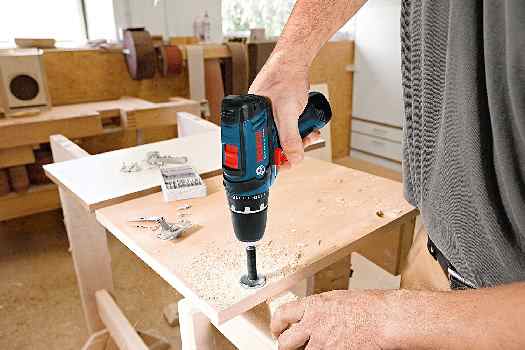This page contains affiliate links. We may earn money or products from the companies mentioned in this post through our independently chosen links, which earn us a commission. Learn More
For the inexperienced do-it-yourself enthusiast or simply a homeowner who desires to go one step beyond just painting walls and hanging pictures, a few special tools are essential. Besides the normal tools found in every handy toolbox, like a hammer, assorted screwdrivers and wrenches, a level and an accurate tape measure, a couple of basic power tools can additionally prove themselves essential.
Corded vs Cordless Drill- When Should You Use Each One?

It is a common belief amony DIY enthusiasts, as well as pro contractors and construction experts, that the most critical power tool to have at home is a drill. Until fairly recently, for a drill to have heavy duty power, the tool you were using needed to be corded. Today, however, cordless drills are readily available with ample power to fit most uses and at a range of prices to accommodate any budget. The tendency nowadays is to regard anything that’s cordless or portable as inherently superior. While in many cases this is true, the fact is that every advantage usually comes with a trade-off, and what is perfect for one scenario is impractical for another. This can be seen especially in the case of an electric drill.
A cordless drill has a million and one uses and is popular in all sectors of the construction and tool industries. Whether it’s metalworking, woodworking, DIY jobs or for small to large scale construction, you will find them everywhere – a great example of the power tool industry to what can be achieved with a little ingenuity.
The cordless drill is what most people choose for their home use, and with good reason. They’re convenient, i.e. portable and easy to use. But they also have two significant downsides: lack of power and the need for batteries. Simply put, cordless drills are often less powerful than their corded brothers, especially when the battery runs low. This is less noticeable nowadays, compared to the past; technology is constantly improving, and cordless products are becoming more powerful and more power efficient. Nevertheless, big jobs, like heavy construction, remain largely in the purview of the corded models.
Batteries can be problematic in the case of cordless drills. They can be quite heavy for a start, and since they almost always attach to the bottom of the drill’s handle, they can feel badly balanced and cumbersome.
Cordless drill batteries can also be costly when bought individually. Most Drill sets come with one, but if the drill is to be used for extended amounts of time then it’s wise to have two, one in use and one on charge. Also, they’ll need to be replaced after a few years whether you use them or not. Even though this is normal for batteries, it should still be taken into account.
“Okay”, you may be saying to yourself, “you’ve convinced me, no more cordless drills for me!” But wait! That’s not what we’re saying at all! The idea is that cordless drills are great in many other aspects.
Corded drills have their annoying qualities as well. Cords come to mind. Everyone hates them, and why shouldn’t they? Besides functioning as a constant potential tripwire for everyone around them, they make storing the drill awkward no matter which method is used. Also, they fray in time, and replacing them is necessary (safety 1st, always) and often more of a pain compared to replacing a battery.
Remember that a tool is as effective as the use it’s designed for? Using the drill in the backyard or on the roof would be awfully unpleasant if it was necessary to link 40 odd feet of extension cords from an outlet to your workspace (to say nothing of safety or maneuverability).
The following summarizes the pros and cons of the two types of drills:
Corded Drills – Pros
- More powerful.
- Cheaper storage – cord won’t wear away like a battery after prolonged storage, requiring you to get a new one.
- Longer use time.
Corded Drills – Cons
- Can’t be operated in case the power times out, or when there is no electrical socket nearby.
- Makes storing the drill awkward.
- Limited mobility.
- Prone to minor hazards (frayed cords, tripping, etc.).
Cordless Drill – Pros
- Portable.
- Easy to use.
- Easy to store.
Cordless Drill – Cons
- They can feel badly balanced, cumbersome and heavy because of the battery.
- Can sometimes lack the power for very rough and tough jobs.
- Battery replacements can be expensive.
Cordless drills were, a brief time ago, inferior to corded drills in every way aside from their portability. Not only did they not have strength, but their batteries required an inconveniently lengthy time to charge, they were awkwardly heavy and cumbersome, and the batteries died way too fast to be of very good use. This level of disconvenience usually came with a significant selling price.
Because of advances in battery engineering, the shortcomings of cordless drills and drivers are now in the past. While a corded drill will continue to be superior to a cordless one in pure strength, nowadays the cordless drill is powerful enough for most jobs around the house. Charge time and weight can be a problem with the cheaper products, but then again – these models come at budget prices perfect for the beginner do-it-yourself enthusiast, who is still building a standard collection of tools. These are also ideal for individuals who like to jump from one hobby to another, and so are unsure how long they are going to be interested in building stuff or do-it-yourself projects.
The power of a cordless tool can be identified by its battery voltage measurement. For basic household tasks, a lightweight drill having 12 volts or even less, often powered by a lithium-ion battery, might be enough. For more advanced tasks, the medium range goes from around 12 to 18 volts, while professionals who have to drill into steel and masonry substances will require heavy-duty tools with 36 volts of electrical power that will tackle light demolition.
Conclusion

When selecting a cordless drill, extra electrical power is not always ideal, especially because power is accompanied by weight. Average 9.6-volt drills weigh roughly 3.5 pounds; a drill having twice the power will weigh about three times as much. The weight and vibration of a heavier running drill, oftentimes at difficult angles, can be fatiguing even for the fittest and muscular arms.
The actual balance of the drill’s handle is also important when thinking about long-term use. Anyone looking for cordless drills needs to hold a lot of models with their batteries attached before purchasing, to make sure that the balance and feel are right.
Cordless drills are a worthy purchase for most consumers, though it will depend on the function needed to be performed. If one does a lot of drilling, chances are there will be times when a ready power-source is unavailable. If the drill will be sitting in the closet 90% of the time, than battery life, storage convenience and intended use should be considered, when deciding whether to get a corded or cordless drill.